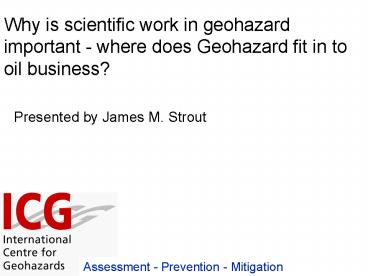Presentasjon - PowerPoint PPT Presentation
1 / 23
Title:
Presentasjon
Description:
Why is scientific work in geohazard important - where does Geohazard fit in ... Gas chimney. Wave generation. Earth-quake. Focus on underwater slope stability ... – PowerPoint PPT presentation
Number of Views:44
Avg rating:3.0/5.0
Title: Presentasjon
1
Why is scientific work in geohazard important -
where does Geohazard fit in to oil business?
Presented by James M. Strout
Assessment - Prevention - Mitigation
2
GEOHAZARDS, WHAT ARE THEY? Events caused by
geological conditions or processes, which
represent serious threats for human lives,
property or the natural environment
Onshore Volcanism Earthquakes Slides/debris
flows Floods Avalanches
Offshore Slope instability Earthquakes Tsunamis Sh
allow gas/hydrates Diapirism
3
INTERNATIONAL CENTRE FOR GEOHAZARDSAssessment,
prevention, mitigation and management
ICG vision Develop knowledge that can help save
lives and reduce material and environmental
damage. To be, within 5 to 8 years, the world
authority and the premier research group on
geo-related natural hazards, with special
emphasis on slide hazards, both on land and
offshore.
4
PARTNERS IN CENTRE OF EXCELLENCE
HOST ORGANISATION Norwegian Geotechnical
Institute (NGI) PARTNERS University of Oslo
(UiO) NTNU Geological Survey of Norway
(NGU) NORSAR
5
Offshore geohazards
6
Focus on underwater slope stability
- Field development on the continental slopes
- Enormous historic and paleo slides observed
- Large runout distances, retrogressive sliding
upslope/laterally and tsunami generation may
threaten 3rd parties in large areas
The Ormen lange field illustrates the importance
of a geohazard study
7
The Storegga Slide (8200 ybp)
Ormen Lange
Field development was contingent on the results
of the geohazards study. It was necessary to -
understand the Storegga slide - survey, sample,
test and monitor to characterise site - develop
failure mechanisms and models - evaluate the
present day stability conditions These studies
resulted in the conclusion that the present day
slopes were stable, and the site was safe for
development.
Headwall 300 km Run-out ? 800 km Volume ?
5.600 km3 Area ? 34.000 km2
8
Geohazards study elements
- Site investigation (geophysical, geological
geotechnical) - Assess in situ conditions and material properties
- Define relevant and critical geo-processes
- Assess interaction of processes
- Identify failure mechanisms
- Identify trigger mechanisms
9
Geohazards study Assessment
- Overall geological understanding of site
- Assessment of probability of occurence
- Calculate/predict consequences
- Uncertainties
- Limited site investigations, measurement and test
data - Modelling of processes and mechanisms
10
Monitoring and measuring
- Key parameters needed
- Seismic survey and metaocean data
- Geological structures, history, sedimentation
rates - Pore pressure and mechanical behaviour of the
soil - Inclination/movement/settlement/subsidence
- Gas releases or seepages
- Vibrations/earthquakes
- Time dependent variable?
- Snapshot measurement w/o time history
- Monitoring w/ time history, e.g. to capture
natural variations, or effects caused by
construction/production activity - Timing before, during and after field
development
11
Closing comments
- Consequences of geohazard events can be very
large, in terms of both project risk and 3rd
party risk - Thorough understanding of natural and human
induced effects is needed in order to identify
the failure scenarios relevant for field
development - Geohazard assessment require multi-discipline
geoscience cooperation and understanding
12
Purpose of geohazards research
- improve our understanding of why geohazards
happen. - assess the risks posed by geohazards.
- prevent the risks when possible.
- mitigate and manage the risks when it is not
possible to prevent them.
13
Thank your for your attention!
14
Overheads illustrating each element of a
geohazard study
15
Geophysical investigationImproved imaging
techniques
16
In situ conditions and material
propertiesCorrelation of geological,
geotechnical, and geophysical parameters
17
Defining critical geo-processes1D Basin model
for Pressure-Temperature time history during
geological time
Deposition rate
Ttemperature phydr. water pressure upore
pressure svertical soil stress seff. soil
stress
18
Contributing processes/interactionGas hydrate
melting caused by climate change after
deglaciation
Geothermal gradient 50?C/km
19
Failure mechanismRetrogressive Sliding
- Development of material and mechanical models
required for explanation of failure on low slope
angles - High excess pore pressure and/or strain softening
(brittleness) required - Local downslope failure (slumping) need to be
triggered for initation of large slide
20
Triggering mechanisms Earthquake analysis
- 1D site response analysis of infinite slope
- Material model for cyclic loading includes pore
pressure generation, cyclic shear strain,
accumulated shear strain - Pore pressure redistribution and dissipation
after earthquake
21
Overall geological understandingOrmen lange the
entire geo-conditions leading to instability
22
Evaluate consequencesTsunami modelling and
prediction
23
Evaluating probabilities
- Variability/incompleteness of data
- Modelling errors
- Recurrence of triggering mechanisms
- Presence of necessary conditions































